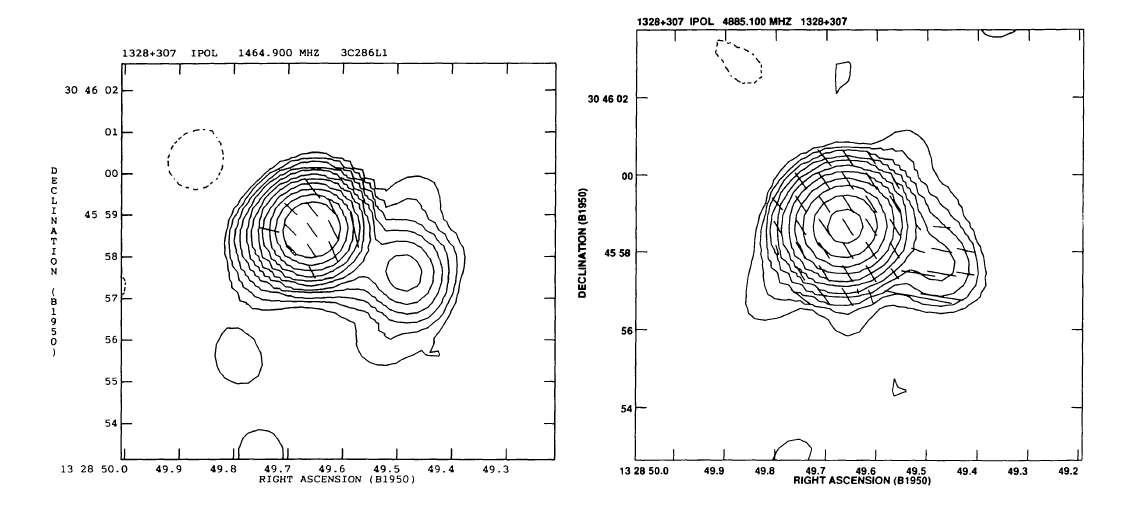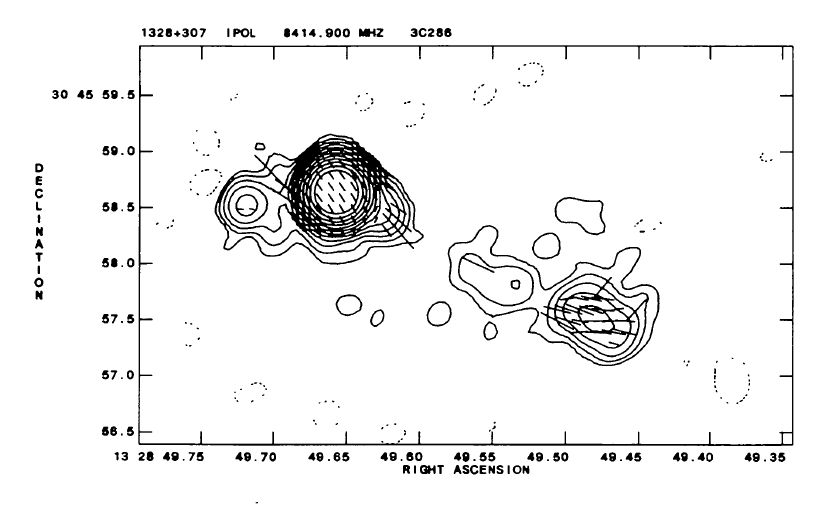3C286 Polarization: Difference between revisions
No edit summary |
|||
| Line 3: | Line 3: | ||
==Science Target Overview== | ==Science Target Overview== | ||
[[File:3c286_14_48.png|200px|thumb|right| | [[File:3c286_14_48.png|200px|thumb|right| Maps of 3C286 at 1.4 and 4.8 GHz. (Akujor & Garrington 1995)]] | ||
[[File:VLA_3c286.png|200px|thumb|right| | [[File:VLA_3c286.png|200px|thumb|right| 3C286 map at 8.4 GHz. The jet to the W of the core is highly polarized with E-vectors parallel to the jet axis at 8.4 GHz. (Akujor & Garrington 1995) ]] | ||
Revision as of 19:25, 19 August 2021
Science Target Overview


These SV observations have been taken with the aim of testing ALMA polarization capabilities at Band 6 (233 GHz, 1 mm).
The target observed is 3C286: a bright, compact, steep-spectrum radio quasar at a redshift of 0.849 (e.g. Hewett & Wild et al. 2010). Radio imaging with the Very Large Array (VLA) at subarcsecond resolution has revealed an extended structure composed of three misaligned bright features. The linear polarization emission is dominated by the two brightest features (see <xr id="1.4_4.8maps" /> and <xr id="8.4map" /> ), and the electric vector position angle is oriented nearly parallel to the axis of the jet like structure between them (Akujor & Garringon 1995).
This source has been widely used as calibrator for linear polarization observations at centimeter wavelengths because of its extremely stable polarization angle (33º at frequencies < 10 GHz). At higher frequencies, however, the polarization angle slowly increases from 33º below 10 GHz to 36º at 45 GHz (VLA results from Perley & Butler 2012). Recent results from IRAM, CARMA, and now ALMA are characterizing the polarization of 3C286 at the much higher frequencies of the millimeter regime.
Details of the ALMA results can be found in the Imaging Guide at the end of the Image Visualization and Analysis section, where we also compare the results with available measurements from IRAM and CARMA.
ALMA Data Overview
This CASA Guide shows the calibration and imaging steps for the ALMA Science Verification data in full polarization targeting the quasar 3C286.
The ALMA Science verification observations on 3C286 in Band 6, were taken in three different datasets (or 1 session) on July 1st, 2014.
The observations consist of three individual data sets (ASDMs), as follows:
- uid___A002_X85c183_X10a
- uid___A002_X85c183_X51a
- uid___A002_X85c183_X822
All four cross correlations (XX, XY, YX, and YY) measurements were observed using a spectral setup with four 2 GHz spectral windows of 64 channels each (TDM mode with 31.25 MHz resolution per channel). To calibrate the instrumental polarization, we sampled a polarized source (J1337-1257) as a function of paralactic angle every 30 minutes for 5 minutes per sample. The strongly polarized source 3C279 was also observed as a bandpass calibrator; however, it can also be used to check the instrumental polarization calibration.
Using the data for publication: The following statement should be included in the acknowledgment of papers using the datasets listed above: "This paper makes use of the following ALMA data: ADS/JAO.ALMA#2011.0.00017.SV. ALMA is a partnership of ESO (representing its member states), NSF (USA) and NINS (Japan), together with NRC (Canada) and NSC and ASIAA (Taiwan), and KASI (Republic of Korea), in cooperation with the Republic of Chile. The Joint ALMA Observatory is operated by ESO, AUI/NRAO and NAOJ."
Obtaining the Data
To download the data, click on the region closest to your location:
Here you will find three gzipped tar files which, after unpacking, will create three directories:
- 3C286_Band6_UncalibratedData - This file contains the raw data files in ALMA Science Data Model (ASDM) format.
- 3C286_Band6_CalibratedData - The fully-calibrated u-v data, ready for imaging.
- 3C286_Band6_ReferenceImages - The final total intensity and polarization images.
You can work with these data products at any of the three stages. To see which files you will need, read on below. The downloads to your local computer will take some time, so you may wish to begin them now.
3C286 Polarization Data Reduction Tutorial
The tutorial (or casaguide) for reducing these data using CASA version 5.4 has been split into calibration and imaging pages:
1) 3C286_Band6Pol_Calibration This section of the tutorial steps you through inspection and calibration of the visibility (u-v) data. To complete this part, you will need the data in the 3C286_Band6_UncalibratedData directory.
2) 3C286_Band6Pol_Imaging This part of the tutorial focuses on constructing images from the fully calibrated visibility data. If you wish to skip calibration and proceed directly to this part of the tutorial, you will need the fully-calibrated visibility data in the 3C286_Band6_CalibratedData directory.
We also provide the final total intensity and polarization images in the 3C286_Band6_ReferenceImages directory.
NOTE: CASA 5.1 or later is required to follow this guide. For more information on obtaining the latest version of CASA, see http://casa.nrao.edu.
- The older CASA 4.3 versions of the casaguides are still available at:3C286_Band6Pol_Calibration_for_CASA_4.3 and 3C286_Band6Pol_Imaging_for_CASA_4.3
- The older CASA 5.1 versions of the casaguides are still available at:3C286_Band6Pol_Calibration_for_CASA_5.1 and 3C286_Band6Pol_Imaging_for_CASA_5.1
How to use this casaguide
For both portions of the guide, we will provide you with the full CASA commands needed to carry out each step.
# In CASA
The commands you need to execute
will be displayed in regions
like this.
Simply copy and paste the commands into your CASA terminal. You may also type the commands in by hand if desired, but be mindful of typos. Note that you may need to hit Enter twice in order for the process to start running. Also note that copying and pasting multiple commands at a time may not work, so only copy and paste the contents of one region at a time.
To learn how to extract the CASA commands into an executable python script, click here.
Occasionally we will also show output to the CASA logger:
This output will be displayed in regions like this.
For a brief introduction to the different ways CASA can be run, click here. For further help getting started with CASA, click here.